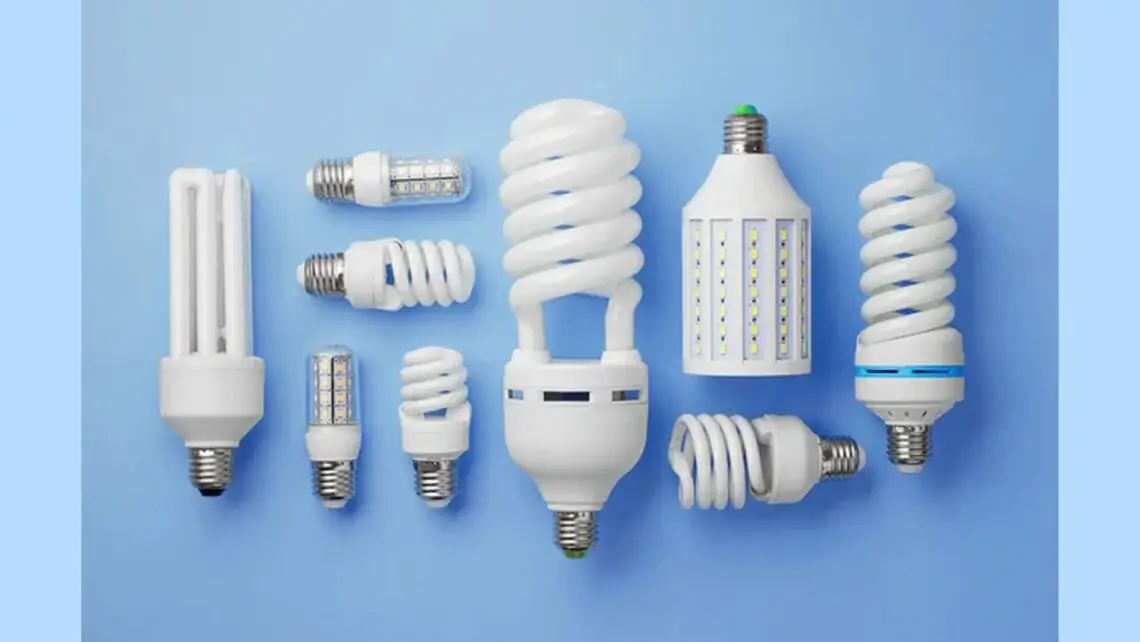Using LED Lightbulbs to Save Money? Think Again!
Of all the homes I’ve assessed for EMFs, about 90% of them have LED lightbulbs somewhere in the house. I have seen extreme levels of dirty electricity on my oscilloscope from many of them. I always suggest that the homeowner switch back to incandescent or halogen bulbs to reduce these harmful effects. The recommendation is not always welcomed. ‘But what about the energy consumption and my utility bill?’ they ask. As it turns out, those LEDs might not be saving you money after all.
My colleague Bill Bathgate has done a lot of his own testing and research on this topic. What he’s discovered was so alarming to me that I wanted to share his findings. Here is a report he wrote in late 2020:
I do not recommend LED bulbs. I realize that perhaps you may think of adding LED lights to save on your power bill, do not do this. All your bulbs should be what is called a “Modified Incandescent”, some call them Halogen bulbs. (https://www.amazon.com/gp/product/B01AGMZ20O/ref=ppx_yo_dt_b_asin_title_o02_s01?ie=UTF8&psc=1) (https://www.amazon.com/gp/product/B00A282UNK/ref=ppx_yo_dt_b_asin_title_o02_s00?ie=UTF8&psc=1)
These halogen bulbs do save energy (about 29% on amps) but do not add any voltage above 60 Hz. For example, on the light bulb box it will say 75 Watts but only consumes 53 watts. Many people are convinced that LED bulbs save energy.
However, this would only be true if the meter on the home was an older “Analog” electromechanical meter (with the old wheel that spun around) that only measured amps. But your new Smart Meter has an electronic chip that measures both peak volts and peak amps, which converts the combined measurement of volts and amps into Volt-Amps (VA), which then via software in the meter converts this to KWh.
So, while you have an amp measurement you also have a voltage measurement that you did not have before. In your specific example, you have 5 extra volts on each leg of your 240 volts system (120 Volts on each leg). Instead of 240 volts, you have 250 volts, even though a voltmeter will say it is only 240 volts! But since voltmeters only measure RMS voltage a voltmeter will never pick up this peak voltage. But the chip in the Smart Meter will.
The other 10 volts (5 volts on each leg) is at a frequency higher than 60 Hz, and no voltmeter can discern this difference. Only an oscilloscope can do this. This sometimes leads a consumer to complain to the electric company that ever since the Smart Meter was installed their bill went up. In my opinion, it is the measurement technique applied that is causing this, not the consumer’s consumption.
In addition, the new Smart Meters have an insidious measurement technique called peak measurement. What this means is that any short-term momentary spike in amperage and voltage is used as the amperage consumption of an entire 15-minute window of consumption.
For example, when an electric motor turns on there is a peak amperage draw for about 0.5 secs. Your bill is calculated for KWh based for a full 15 minutes based on this peak amperage and voltage draw, not the average over 15 minutes.
These added dirty electricity voltages above 60 Hz are actually adding to your bill. Your LED bulbs and dimmer switches are not helping your electric bill because they are adding voltages which you are charged for. You should be 0.5 volts max.
The LED bulbs and dimmer switches typically increase this voltage causing a large difference. The only person that gains from LED bulbs is the electric company. The Electric company’s primary cost is generating amps, not voltage.
Utilities do not expend operating costs to generate voltages, this is done with transformers at the substation. There is no operating cost to have a substation other than the capital required. After the initial voltage created by the utility generator, all voltage is a function of transformers. So, it really does not cost the utility to create volts. But as the amps demand goes up it does cost them more fuel to service the load, which is amps.
Here is an example of a “Modified Incandescent” bulb on the Oscilloscope. The Red trace is the primary voltage and the yellow trace is in amps.

You will note the Amps follow the voltage in a uniform pattern. This is normal.
Below is an LED lightbulb scope image. Note that the waveform is very irregular. This can have a biological impact because the amperage is not uniform, it is a type of spike waveform causing your body’s nervous system to react to these jolts.
These surges in amperage are highly disruptive to the human body in particular to the heart muscles and synapses in the brain and nervous system. In addition, this irregular pattern contributes to the flicker of the light. This flicker contributes to the development of cataracts.
Today children as young as 10 years old are being diagnosed with cataracts. This was unheard of 8 years ago. In addition, the total number of cataract cases has grown to levels unheard of. I consider the use of LED bulbs to be a serious health risk.
The LED bulb’s light spectrum is skewed more toward the blue to UV light spectrum. There is less yellow and red spectrum. Again, I want to emphasize there is little yellow or red spectrum. A modified Incandescent has the full light spectrum from blue to red and everything in between and it is all balanced.
It is proven that high concentrations of blue to UV light does lead to cataracts. Ask any optometrist and they will tell you the same thing. Also, review this recent study on blue light from LEDs and aging.
Here is the LED Bulb Scope Image, the red is voltage and the yellow is current.

Typical Incandescent Bulb Color Spectrum Image:

Color optical wavelength Images from LED bulbs and Florescent bulbs

Here are some videos of our colleague Rob Workman testing different lights:Lightbulb test: https://youtu.be/WR-PHo3ZWn8
LED TV test: https://www.youtube.com/watch?v=YzovYO81Y3c
LED Dementia Connection: https://youtu.be/Tw3LJ94ALJ8
I hope you are coming to realize the marketing deception of some of our modern conveniences like LED lightbulbs. I have retrofitted several homes including my own home from LED bulbs back to modified Incandescent bulbs and their electric bill went down! LED bulbs are a serious health hazard and it is more than just the dirty electricity that comes from it.







Thank you for that valuable info.
William, we use LED bulbs that are yellow, so that they have a warm look identical to incandescent. Are these safer for cataracts? Thanks, Amy
You have more credits on your electrical studies than mine but I still have the sufficient knowledge to ask below. Yes the color spectrum I also read elsewhere and it is absolute truth. But somehow can be managed by clothing and blue filtering eye glasses. Also not all led light are bright white, one can chose yellow light leds, too. Flicker is still a problem but can be reduced by mixed lightning. With smart meter readings my real question is coming up. OK, smart meter is “smart enough” to charge you more money by reading peaks. But those peaks come with washing machines and refrigarators (ie motors) not bulbs of any kind (and if it does, perhaps with old flurescant tubes with coil starters and certainly not leds or they voltage reducing circuitry still based on coils???). Also can you please explain in more simpler terms if I replace my 100W incandescant lamp with 7W LED what trick smart meter can do to charge me still more than 100W consumption. I guess you are writing from US. So 240V and 60 Hz is your calculations, ok. So, yes, the led will flicker but it actually works with very low DC current and with very low voltage. All led bulbs in fact has voltage reducing circuitry as our phone chargers. So why your ossiloscope pictures show perfect sinus voltage and very weird current shape?
I have already told you how the utility meter calculates the volts and Amps. You need to look at peak values and not RMS values. So if you buy a LED bulb that the label says is on 9 W, that is only a RMS or averaged value. So when you see the spike of the current waveform, that spike is what is used in the electric meter to calculate your bill. A very neat little trick.
I have already made wagers with consumers after I have surveyed their home that if during the months of May and September (Months where A/C load is not there in the US) they share with me those bills and if they switch to regular non LED bulbs from All LED’s and there bill goes up by more that 5% I will pay their bill. So far out of 12 bets like this I have not lost one bet yet. I know a dishonest person can deceive me on this, but that was a risk I took. With regards to the question on light spectrum you are deceiving yourself, a “yellow” LED is not a real point. If you have a light spectrum meter you will see what my charts show, whether it is a “Yellow” bulb or not.
Can you provide documentation for how these new meters calculate usage? Wouldn’t it vary from model to model as well? Wouldn’t there be public outcry if more and more people are getting hit with much higher electric bills, with whistleblowers revealing this trick?
So many people are providing so much disinformation these days to promote distrust, polarization, and unrest, that anyone honest will be glad to document their claims.
I’m not even sure I understand what you’re describing as the new billing method. (And you imply that all electric companies use this method.) Do you mean that the meter divides the day into 15-minute periods, and during each one, the meter detects the highest instantaneous amount of volts x amps consumed, and that amount is then treated as though it was being constantly during that period? That would mean that running a 1500 watt space heater for 10 seconds would cost the same as running it for 15 minutes.
Do not blame the LED
its the cheap LED Drivers that get bundled in the packages
plus US has a shitty way of doing their power metering